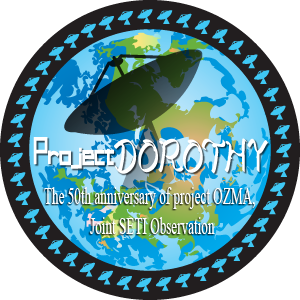
Detailed Informations of Project Dorothy
TS
1st. run (main): 5-7 Nov. 2010
2nd. run (additional): 23-26 Nov. 2010
3rd. run (urgent, Kepler planets): 3 Mar. - 22 May 2011
4th. run (special, first anniversary of Prof. M. Morimoto's death ): 16 Nov. 2011
5th. run (Sgr A*+G2 event, Magic Time SETI): 1 Jul. 2013 - on

log of 1st run.
Observatories
mark *: data analysis is finished
(Hat Creek Observatory, California) of SETI Institute
40.817dN, 121.470dW (290 miles northeast of San Francisco)
This observation is a part of setiQuest.
1st. run
additional surprise observation: 20 MHz, 30 million channels
UTC 5th Nov. 16:50+30 minutes on 55 CnC near 1420 MHz with 8 bandwidth.
+ Gl 581.
(and O-type stars; Dr. Seth Shostak suggested that advanced civilizations might build transmitters close to powerful sources of energy, like O stars)
HD093521
HD060848
HD064568
Zeta Oph
Moon (a background observation)
HD157858
HD172175
HD166734
BD114586
main observation: UTC 6 Nov. 08:00-12:00 (PDT 6 Nov. 01:00-05:00)
1400-1500 MHz, frequency resolution: 0.7 Hz
commensal mode with the high-throughput Prelude signal analyzer covering about 100 MHz (documents narrowband signals found) and the setiQuest raw data collector which gathers raw data with 8 MHz bandwidth. spend about 30 minutes on the 5 main targets
targets: Tau Cet, Eta Ari, Epsilon Eri, HD 69830 and 55 CnC
(ATA is a 25 antenna element interferometer equipped with phased array beamformers. The total collecting area is 1100 square meters with an aperture efficiency of 63%.)
sample of data
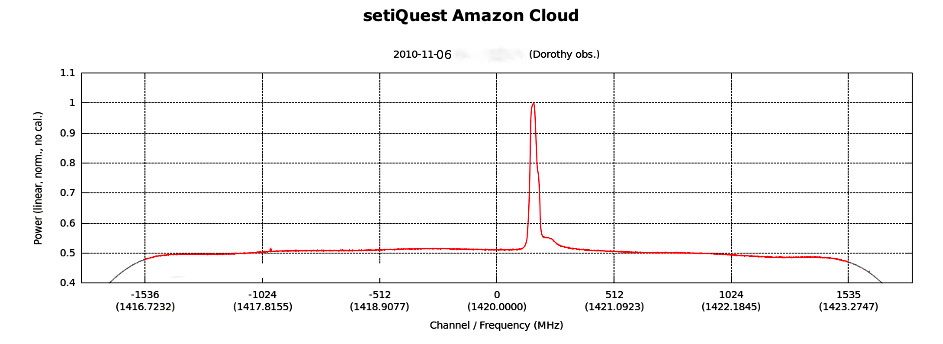 One sample of data obtained with ATA of SETI Institute
(frequency on x-axis, power on y-axis). The central peak is HI emission line (not ETI signal).
One sample of data obtained with ATA of SETI Institute
(frequency on x-axis, power on y-axis). The central peak is HI emission line (not ETI signal).
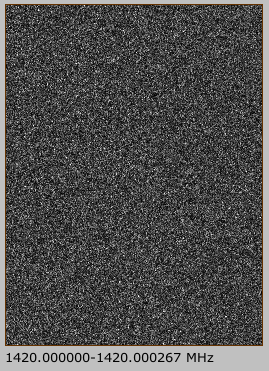
The time series graph (frequency on x-axis, time on y-axis) at 1 Hz resolution. An ETI beacon might be expected to be nearly a straight line, but these is no signal in this sample.
5th. run
6.7-9 GHz
18d20m39sN, 66d45m10sW (Puerto Rico, in the northeastern Caribbean Sea)
300m(the largest radio telescope in the world)
University California of Berkeley SETI team collected 2.5 MHz raw baseband data at 1420 MHz from 7 dual
polarization feeds (SETI@home), and also performing 1 Hz resolution
spectroscopy across a 200 MHz band (1300-1500 MHz), switched between beams
(SERENDIP).
1st run
Nov 5: 19:00-24:00 UT
Nov 6: 04:30-06:30, 14:30-24:00 UT
Nov 7: 04:15-06:30, 14:15-24:00 UT
38d25m59.23sN, 79d50m23.40sW(about 150 miles of west of Washington D.C.)
100 by 110 m
user: University California of Berkeley
3rd. run
(UTC) May 2011
07 21:30-22:30
08 12:00-15:15
10 02:15-06:45
15 03:00-08:00
16 12:15-16:30
20 02:15-08:00
22 12:00-13:45
GBT Schedule
1.35 - 1.75 GHz
UCB team recorded 800 MHz of raw voltage data in two
polarizations, to be analyzed both locally and with SETI@Home.
They will
search for a wide variety signals, including broadband dispersed pulses
and CW tones to about 1/20 Hz.
Targets are 102 Kepler Goldilocks planetary candidates [include two Japanese targets (KOI268 and KOI701) and Kepler-22b].
UC Berkeley SETI survey focuses on Kepler’s top Earth-like planets
SETI at the Green Bank Telescope
Kepler SETI Observations Complete!
The Search for Extra Terrestrial Inteligence at UC Berekeley
see Siemion (2013)
42.5057, -71.55726
(about 26 miles northwest of Boston)
180cm (transit) optical telescope (OSETI)
1 minute / star
1st. run
33d45m34sS, 150d44m49sE (Werrington)
Australian Optical SETI Project, 0.6 m optical telescope (UWS Observatory at the Werrington North campus)
(This team could not observe due to various reasons.)
37d27mN, 127d00mE (Gwacheon City=neighbor Seoul)
7.2m single dish
1st. Run
Tau Ceti UT12:00-12:20 (KST21:00-21:20) Nov 6, 2010
1420 MHz, 1M channel spectrometer (frequency bandwidth 20MHz)
Epsilon Eridani UT12:40-13:00 (KST21:40-22:00) Nov 6, 2010
1420 MHz, 1M channel spectrometer (frequency bandwidth 20MHz)
30d43m17.34sS, 21d24m38.46dE (about 280 miles northeast of Cape Town)
12m dish ("MeerKAT"), 1420 MHz, BW=4 MHz
2nd.Run
observational date: 23rd. Nov. 2010
Epsilon Eri: start 18h00 UTC
Eta Arietis: start 18h30 UTC
Tau Ceti: start 21h00 UTC
20 mins on each, 64 MHz bandwidth centered on 1420 MHz. Raw data recording.
In the end, KAT-7 team recorded about 8 mins of H-polarization raw data on
each in a band from 1408 MHz to 1472 MHz.
MeerKAT team recorded the raw voltage data which is immediately after the analogue to digital converter and a digital downconversion and filtering step. In the analysis they look both at voltage power over time and also at spectral power over time.
(INAF, IRA)
44d31m15sN, 11d38m49sE (about 70 miles southeast of Venezia)
32m single dish, 1420 MHz, BW=16 MHz, frequency resolution=0.7 Hz, 24 million channels spectrometer
1st. Run
observational schedule: Nov. 6-7th, 2010
UT 07:00 - 10:30 55 CnC
UT 10:30 - 14:00 Gl 581
UT 14:00 - 18:00 HD 168746
UT 20:00 - 00:00 Tau Cet
UT 00:00 - 02:00 Eta Ari
UT 02:00 - 04:00 Epsilon Eri
UT 04:00 - 06:00 HD 69830
1st. Run
2010-11-05 (UT) 22:10:01-22:30:12 Tau Cet
2010-11-06 (UT) 00:01:01-00:21:13 Epsilon Eri
frequency (center): 150 MHz
frequency resolution: 1 Hz
band-width: 6Hz
LOFAR Schedule
51.145dN, 1.43667dW (Chilbolton Observatory, 63 miles southwest of London)
3rd. Run
early (Euro-) mornings of the 3rd and 4th of March 2011
frequency: 180 MHz
frequency resolution: 1 Hz
band-widh: 36 MHz
Testing SETI with LOFAR
(Nancay Radio Telescope/Observatoire de Paris)
47d23m N, 2d12m E (about 80 miles south of Paris)
100m meridian telescope
Position switch : pairs (ON, OFF) of 40 sec acquisitions.
Use of a correlator, with the following setup :
1 spectrum per sec with 4096 frequency channels per polarization 2 linear polarisations: vertical and horizontal.
Observed sky frequency band was 1401-1426 MHz.
resolution = 25 MHz/4096 = 6.1 kHz
Data are calibrated (Jy) with the help of a noise diode, measured before each ON or OFF phase.
Observations log
UT time stands for start of data acquisition.
N is number of successive (ON, OFF) pairs of 40 sec acquisitions.
1st Run
dd mm yyyy UT time N Source
04 11 2010 23:57:43 28 Epsilon Eridani <- first observation of Project Dorothy
05 11 2010 04:40:52 26 HD 69830
05 11 2010 11:40:01 33 Gl 581
05 11 2010 23:51:21 33 Epsilon Eridani
06 11 2010 04:41:46 30 HD 69830
06 11 2010 11:36:06 33 Gl 581
06 11 2010 23:47:25 10 Epsilon Eridani
2nd. Run
dd mm yyyy UT time N Source
26 11 2010 03:49:23 25 55 Cancri
sample of data
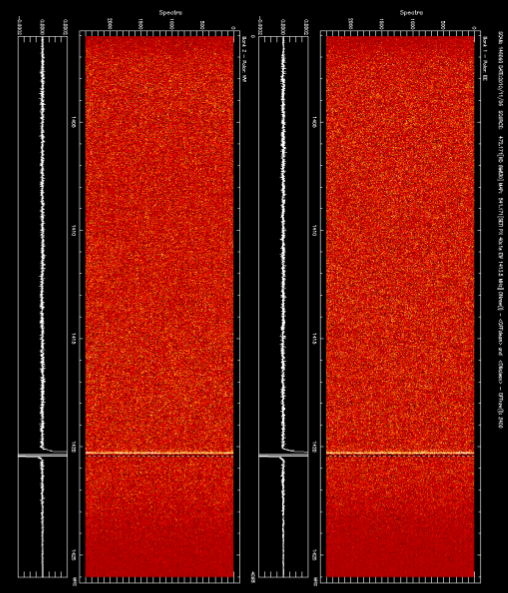 One sample of data (HD 69830) obtained with 100m radio telescope of NRT.
Parts at 1420 MHz are HI emission lines (not ETI signal).
One sample of data (HD 69830) obtained with 100m radio telescope of NRT.
Parts at 1420 MHz are HI emission lines (not ETI signal).
about 65 miles southwest of Barcelona
5th. Run
34.8663030dS, 58.140035dW (about 20 miles southeast of Buenos Aires)
Two 30 m antennas
1st. Run
IAR team have observed Tau Ceti and Epsilon Eridani for 2hours each day each star
Nov. 5 2010 each star:
2 hours 1420 +/- 5 MHz with a spectral resolution of 0.05 Hz and a sensitivity of 2x10^-23 watts m^-2
Nov. 6 2010 each star:
2 hours 1667 +/- 5 MHz with a spectral resolution of 0.05 Hz and a sensitivity of 2.3x10^-23 watts m^-2
*Takahashi Radio Station
(Kyoto City)
6m single dish "MIYABI" 1420 MHz, BW=0.8 MHz
left- hand circular polarization, spectroscopic observation with the FFT
frequency resolution= 1 Hz
1st. Run
Observational date: 5th Nov. 2010
UTC 12-13h (JST 21-22h) Tau Cet
UTC 13-14h (JST 22-23h) Epsion Eri
2nd. Run
25th. Nov. 2010
UTC 12-13h (JST 21-22h) Tau Cet
UTC 13-14h (JST 22-23h) Epsion Eri
3rd. Run
5th. Mar. 2011
UTC 3:00-3:30 (JST 12:00-12:30) KOI 268
UTC 3:30-4:00 (JST 12:30-13:30) KOI 701
4th. Run
UTC 15th 15:00-17:00 (JST 16th 00:00-02:00) Eta Ari (simultaneous observation with Tokai Uiv.)
UTC 16th 11:00-15:00 (JST 16th 20:00-24:00) Eta Ari (simultaneous observation with Tokai Uiv.)
34d12m58sN, 131d33m26sE (Yamaguchi City=about 220 miles west of Osaka)
32 m single dish
simultaneous observation of right- and left- handed circular polarization, spectroscopic observation with the FFT
* 1st. Run
8302 MHz, BW=4 MHz, antenna beam=4 arc-minute.
frequency resolution=61 Hz, flux limit=10^-24 [W/m^2]
observational date: 6th Nov. 2010 (simultaneous observation with Tokai Uiv.)
UTC 12-15h (JST 21-24h) Tau Cet
UTC 15-18h (JST 24-27h) Epsilon Eri
4th. Run
6668 MHz, BW=4 MHz
observational date: 16th Nov. 2011
UT 16:50-17:00 (JST 01:50-02:00) Eta Ari (simultaneous observation with Takahashi and Tokai Uiv.)
UT 02:05-02:15 (JST 02:05-02:15) 55 CnC (simultaneous observation with Tokai Uiv.)
32d50m09.5400sN, 130d52m09.4440sE (Mashiki, Kumamoto, Kyushu)
All observations are done by RHCP(right- handed circular polarization).
* 1st. Run
11m single dish
1) total power observation (8302+-100 MHz, sampling time=200 ms, flux limit=10^-18 [W/m^2])
2) spectroscopic observation (8302+-2.0 MHz, frequency resolution=10 KHz, flux limit=10^-20 [W/m^2]) with the spectrum analyzer
5m single dish
1) total power observation (8302+-150 MHz, sampling time=200ms, flux limit=10^-17 [W/m^2])
2) spectroscopic observation (8302+-2.0 MHz, frequency resolution=10 KHz, flux limit=10^-20 [W/m^2]) with the spectrum analyzer
observational date: 6th Nov. 2010 (simultaneous observation with Yamaguchi Uiv.)
UTC 12-15h (JST 21-24h) Tau Cet
UTC 15-18h (JST 24-27h) Epsilon Eri
* 3rd. Run
11m single dish
1) Total power detection at 8105 MHz +/- 100 MHz with sampling time=200 ms
2) Spectrum observation at 8105MHz +/- 2MHz with RBW=10kHz and about 1second for 1 sweep.
observational date: 3-6th Mar. 2011
UTC 4:00-4:30 (JST 13:00-13:30) KOI 268
UTC 4:30-5:00 (JST 13:30-14:30) KOI 701
4th. Run
11m single dish
8.302 GHz +/- 100 MHz
UTC 15th Nov. 15:00-17:00 (JST 16th 00:00-02:00) Eta Ari (simultaneous observation with Takahashi)
UTC 15th Nov. 17:00 - 16th 01:00 (JST 16th 02:00-010:00) 55 CnC
UTC 16th Nov. 01:00-06:00 (JST 16th 10:00-15:00) KOI 701
UTC 16th Nov. 06:00-11:00 (JST 16th 15:00-20:00) KOI 268 (simultaneous observation with Wakayama Uiv.)
UTC 16th Nov. 11:00-15:00 (JST 16th 20:00-24:00) Eta Ari (simultaneous observation with Takahashi)
Institute for Education on Space of Wakayama University
34.26725N, 135.1501E (Wakayama City=about 37 miles southwest of Osaka)
4th. Run
12m single dish, 1420 MHz, integral time 3min., BW=32MHz, 1channel=16KHz
UTC 16th Nov. 06:00-11:00 (JST 16th 15:00-20:00) KOI 268 (simultaneous observation with Tokai Uiv.)
5th. Run
1, 2, 5 Jul. and 8 Aug. 2013 1420 MHz
*Agawa Jovian Radio Observatory of Kochi National College of Technology/NASA
33d34mN, 133d06mE (Niiyodogawa, Kochi Prif., Shikoku)
log periodic with 9 orthographic elements
30-35 MHz, BW=50 KHz, resolution= 4096 points, Sweep time= 70 msec, 6 minutes averaging method
UTC 16th 11:22:30-13:00 (JST 16th 20:22:30-22:00) Eta Ari (simultaneous observation with Takahashi and Tokai Uiv.)
1st. Run: ATA, Harvard Univ., Gwacheon, LOFAR, Nancay, Medicina, IAR, Takahasi, Tokai and Arecibo(UCB)
2nd. Run: SKA South Africa, Takahashi and Nancay
3rd. Run: Green Bank (UCB), LOFAR-UK, Takahashi and Tokai
4th. Run: Takahashi, Wakayama, Agawa, Yamaguchi and Tokai
5th. Run: ATA, EB3FRN and Wakayama
Targets

Tau Ceti
HIP 8102 = HD 10700 = HR 509
01h44m04.0829s, -15d56m14.928s (ICRS coord. 2000)
One of the OZMA objects
distance=12 light years, spectral type=G8V, V=3.5 mag.
There may be the hot grain desk (Di Folco 2007).
But no planet is discovered.
(One Habitable planet was discovered in 2012)
Eta Arietis
HIP 10306 = HD 13555 = HR 646
02h12m48.0855s, +21d12m39.575s (ICRS coord. 2000)
distance=98 light years, spectral type=F5V, V=5.2mag., HabCat star
No plant has been discovered.
Epsilon Eridani
HIP 16537 = HD 22049 = HR 1084
03h32m55.8442s, -09d27m29.744s (ICRS coord. 2000)
One of the OZMA objects
distance=11 light years, spectral type=K2V, V=3.7 mag., age=0.66 Giga years
These are the silicate halo, ice-silicate ring and two warm rings (e.g. Backman et al. 2009).
One Jupiter-size planet and one unconfirmed planet are discovered.
HD 69830
HIP 40693 = HR 3259
08h18m23.9473s, -12d37m55.824s (ICRS coord. 2000) (Puppis)
distance=41 light years, spectral type=K0V, V=6.0mag, HabCat star
The outermost (HD 69830 d, 1 Neptune Mass) of 3 planets locates in the Goldilocks (Habitable) Zone (Lovis et al. 2006, Rugheimer and Haghighipour 2007).
The thick dust belt giving rise to the IR excess is located at about 1 AU (out of planet's orbit).
55 Cancri
HIP 43587 = HD 75732 = HR 3522
08h52m35.8112s, +28d19m50.947s (ICRS coord. 2000)
distance=40 light years, spectral type=G8V, V=6.0mag., age=5.5 Giga years, HabCat star
One (55 CnC f, 0.14 Jupiter Mass) of five planets is located in the Goldilocks Zone (Fischer et al. 2008, von Braun et al. 2011).
Gliese 581
GJ 581, HIP 74995
15h19m26.8250s, -07d43m20.209s (ICRS coord. 2000)
distance=20 light years, spectral type=M3, V=10.6mag., age=4.3 Giga years, HabCat star
At least one planet (GJ 581 d, 7 Earth Mass) is located in the Goldilocks Zone (e.g., von Paris 2010, Wordsworth et al. 2011, Hu and Ding 2011)
HD 168746
HIP 90004
18h21m49.7832s, -11d55m21.660s (ICRS coord. 2000) (Scuti)
distance=140 lighr years, spectral type=G5, V=8.0mag., age=3.75 Giga years, HabCat star
One planet (0.23 Jupiter Mass) is discovered.
If these is the Earth mass planet, it can remain in the classical Goldilocks Zone at least 1000 Mega years (Jones et al. 2006).
*) HabCat: Catalog of Habitable Stellar System (Turnbull and Tarter 2003)
Kepler Goldilocks planetary candidates
see Siemion (2013)
(at 3rd. Run)
direction of Sgr A*
Dr. Fujishita's idea
we need the information on when (timing) and where
(direction) ETI emits the signal.
It is suggested that a gas cloud is falling into the accretion zone of
the super-massive black hole (Sgr A*) at the Galactic Center. A giant radiation flare
is expected in the summer of 2013. We are proposing a new approach of SETI.
If ETIs exist and radiate some signals to opposite site of this flare. The
farther ETI from Galactic center (including us) might be able to detect
their signals. In this case, we can solve the questions of when and where
(which direction) to detect ETI’s signal.
see Fujishita et al. (2014)

(at 5th. Run)
1st. Run: Tau Cet, Eta Ari, Epsilon Eri, HD 69830, 55 CnC, GJ 581, HD 168746,
2nd. Run: Tau Cet, Eta Ari, Epsilon Eri, 55 Cnc
3rd. Run: Kepler Goldilocks planetary candidates
4th. Run: Eta Ari, 55 CnC, two Kepler Goldilocks planetary candidates
5th. Run: Galactic Center (direction of Sgr A* + G2)
(Arecibo antenna observed unique targets of UCB SETI@home and SERENDIP.)
Frequencies
 (1st. - 3rd. Run)
(1st. - 3rd. Run)
Agawa: 30-35 MHz
References
Backman et al. 2009 Astrophysical Journal 680, 1522
Di Folco et al. 2007 Astronomy and Astrophysics 475, 243
Fischer et al. 2008 Astrophysical Journal 675, 790
Fujishita et al. 2014 ICIC Express Letters (accepted)
Hu and Ding 2011 Astronomy and Astrophysics 526, A135
Jones et al. 2006 Astrophysical Journal 649, 1010
Lisse et al. 2007 Astrophysical Journal 658, 584
Lovis, C. et al. 2006 Nature, 441, 305
Rugheimer and Haghighipour 2007 Bulletin of the American Astronomy Society 38, 203
Siemion, A. et al. 2031 ApJ 767 94
Turnbull and Tarter 2003 Astrophysical Journal Supplement Seres 145, 181
von Braun et al. 2011 Astrophysical Journal, 740, 49
von Paris et al. 2010 Astronomy and Astrophysics 522, A23
Wordworth et al. 2011 Astrophysical Journal Letter, 733, L48
Project Member
Honorary adviser
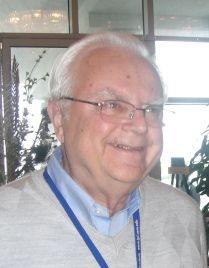
Prof. Frank Drake (Chairman Emeritus of SETI Institute)
Working group
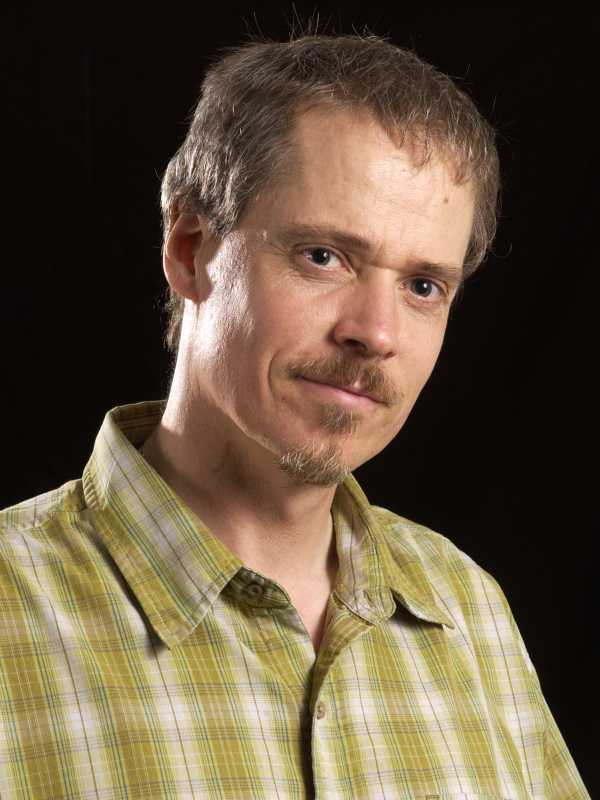
G. R. Harp (SETI Institute)
Life at the SETI Institute: Dr. Gerry Harp -- Deciphering Celestial Signals in a New Way
Discussion / Live Q and A's / Dr. Gerald Harp's answers
HARP'S LIST OF PUBLICATIONS
SETI Algorithms on the ATA - Gerry Harp (SETI Talks)

Mitsumi Fujishita (Tokai University, Japan)

Andrew Siemion (UC Berkeley)

Doug Vakoch (SETI Institute)

Shin-ya Narusawa (Nishi-Harima Astronomical Observatory, University of Hyogo, Japan)
Observers and Collaborators of Project Dorothy
Rob Ackermann (SETI Institute)
Alfredo Astorga (SETI Institute)
Peter Backus (SETI Institute)
Marco Batrolini (INAF, IRA, Italy)
Ragbir Bhathal (University of Western Sydney, Australia)
Samantha Blair (SETI Institute)Interstellar Medium Interference - Samantha Blair (SETI Talks)
Lourdes Cahuich (Mexico)
Iban Cardona (EB3FRN, SETI League, Spain)
Tobia Carozzi (Onsala Space Observatory, Sweden)
Pierre Colom (Observatoire de Paris, France)
Heino Falcke(Radboud University, Netherlands / LOFAR)
Rob Fender(University of Southampton, UK / LOFAR)
Kenta Fujisawa (Yamaguchi University, Japan)
Vishal Gajjar (GMRT, India)
Mike Garrett (LOFAR)
Hiroyuki Geshiro (Geshiro-Gumi Machinery MFG Company, Japan)
Paul Horowitze (Harvard University)
Jasper Horrell (SKA South Africa)
Kazumasa Imai (Kochi national College of Technology, Japan)
Takafumi Ishida (Yamaguchi University)
Eric J. Korpela (UC Berkeley)
Kang Hwan Lee (Gwacheon National Science Museum, South Korea)
Guillermo A. Lemarchand (Instituto Argentino de Radioastronomia)
Andrea Mattana (Istituto Nazionale di Astrofisica, Italy)
Jean-Michel Martin (Observatoire de Paris, France)
Curtis C. Mead (Harvard University)
Stelio Montebugnoli (INAF, IRA, Italy)
Jader Monari (INAF, IRA, Italy)
the late Masaki Morimoto (Nishi-Harima Astronomical Observatory, Japan)
Takahiro Morimoto (Yamaguchi University, Japan)
Ian S. Morrison (Australian Centre for Astrobiology/University of New South Wales)
Hiroshi Nagira (Yamaguchi University, Japan)
Halca Nagoshi (Yamaguchi University, Japan)
Hiroyuki Naito (Nagoya University, Japan)
Yusei Nanto (emblem designer, Japan)
Bob Nichol (Univ. Portsmouth, UK / LOFAR)
Masami Okyudo (Wakayama University, Japan)
Toshimitsu Ono (Niyodogawa town, Japan)
Andrea Orlati (INAF, IRA, Italy)
Jong-Hyun Park (Korean Amateur Astronomical Society)
Alan Penny (The University of St Andrews, UK / LOFAR)
Antonis Polatidis (LOFAR)
Giuseppe Pupillo (INAF, IRA, Italy)
Simon Ratcliffe (SKA South Africa)
Myung-Hyun Rhee (Korea Astronomy and Space Science Institute)
Simona Righini (INAF, IRA, Italy)
Emma Salerno (INAF, IRA, Italy)
Naoko Sato (Wakayama University, Japan)
Nagisa Shino (Yamaguchi University. Japan)
Seth Shostak (SETI Institute)New SETI strategies - Seth Shostak (SETI Talks)
Yoshitaka Takahashi (Takahashi Radio Station, Japan)
Jill Tarter (SETI Institute) The Allen Telescope Array (SETI Talks)
Naoto Tatsumi (Ryuten Astronomical Observatory, Japan)
Gilles Theureau (Observatoire de Paris, France)
Wim van Driel (Observatoire de Paris, France)
Sander ter Veen (Radboud University, Netherlands / LOFAR)
Dan Werthimer (UC Berkeley)Is Anybody Out There? Searching for ET with SETI@home
Michael Wise (LOFAR)
Shelley Wright (UC Berkeley -> University of Toronto)
Yokotsuka (Tokai University Space Information Center, Japan)
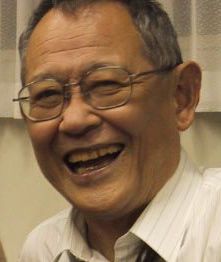
One of this project members, Dr. Masaki Morimoto passed away due to cardiac failure on 16th Nov. 2010 at the age of 78.
Dr. Morimoto is a honorary advisor of Nisih-Harima Astronomical Observatory.
He was an emeritus professor of Tokyo University, National Astronomical Observatory of Japan
and Kagoshima University.
He was the father of Japanese Radio Astronomy. He was the driving force in constructions of
Nobeyama Radio Astronomical Observatory
and the Space Radio Observatory "HARUKA" (VSOP). Dr. Morimoto was also the president of the Division Commission 40 (Radio Astronomy) of International Astronomical Union.
And he was one of Japanese SETI pioneers. Dr. Morimoto and his collaborators suggested new magic frequency 4829.659 MHz (Morimoto et al. 1978 Nature 276, 694).
May his soul rest in peace.
"Morimoto-San was a wonderful Japanese 'uncle' to so many young people - he left behind a very large family and will be missed by all." - Jill Tarter -
SERENDIP
Laura Spitler (Cornell University)
James Cordes (Cornell University)
Eric Korpela (Space Sciences Laboratory)
Matt Lebofsky (Space Sciences Laboratory)
Jeff Cobb (Space Sciences Laboratory)
Mark Wagner (Berkeley Wireless Research Center)
Dan Werthimer (Space Sciences Laboratory)
Terry Filiba (UC Berkeley Electrical Engineering Department)
Henry Chen (UC Los Angeles Electrical Engineering Department)
Griffin Foster (Oxford University)
SETI@home
Eric Korpela (Space Sciences Laboratory)
Matt Lebofsky (Space Sciences Laboratory)
Jeff Cobb (Space Sciences Laboratory)
Dan Werthimer (Space Sciences Laboratory)
Dave Anderson (Space Sciences Laboratory)
Arielle Little (UC Berkeley Physics)
KEPLER @ GBT
Jill Tarter (SETI Institute)
Paul Demorest (National Radio Astronomy Observatory)
Ron Maddalena (National Radio Astronomy Observatory)
Glen Langston (National Radio Astronomy Observatory)
John Ford (National Radio Astronomy Observatory)
Eric Korpela (Space Sciences Laboratory)
Matt Lebofsky (Space Sciences Laboratory)
Jeff Cobb (Space Sciences Laboratory)
Dan Werthimer (Space Sciences Laboratory)
Arielle Little (UC Berkeley Physics)
Geoff Marcy (UC Berkeley Astronomy)
Andrew Howard (UC Berkeley Astronomy)

 One sample of data obtained with ATA of SETI Institute
(frequency on x-axis, power on y-axis). The central peak is HI emission line (not ETI signal).
One sample of data obtained with ATA of SETI Institute
(frequency on x-axis, power on y-axis). The central peak is HI emission line (not ETI signal).

 One sample of data (HD 69830) obtained with 100m radio telescope of NRT.
Parts at 1420 MHz are HI emission lines (not ETI signal).
One sample of data (HD 69830) obtained with 100m radio telescope of NRT.
Parts at 1420 MHz are HI emission lines (not ETI signal).






